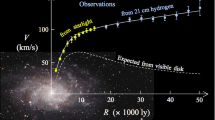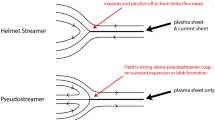Abstract
Understanding the star formation process is central to much of modern astrophysics. Stellar birth is intimately linked to the dynamical behavior of the parental gas cloud. Gravoturbulent fragmentation determines where and when protostellar cores form, and how they contract and grow in mass via accretion from the surrounding cloud material to build up stars. Supersonic turbulence can provide support against gravitational collapse on global scales, whereas at the same time it produces localized density enhancements that allow for collapse on small scales. The efficiency and timescale of stellar birth in Galactic molecular clouds strongly depend on the properties of the interstellar turbulent velocity field, with slow, inefficient, isolated star formation being a hallmark of turbulent support, and fast, efficient, clustered star formation occurring in its absence.
Similar content being viewed by others
References
Adams, F.C. and Myers, P.C.: 2001, ApJ 553, 744.
Bate, M.R. and Burkert, A.: 1997, MNRAS 288, 1060.
Ballesteros-Paredes, J., Hartmann, L. and Vázquez-Semadeni, E.: 1999b, ApJ 527, 285.
Ballesteros-Paredes, J., Klessen, R.S. and Vázquez-Semadeni, E.: 2003, ApJ 592, 188.
Ballesteros-Paredes, J., Vázquez-Semadeni, E. and Scalo, J.: 1999a, ApJ 515, 286.
Benz, W.: 1990, in: J.R. Buchler (ed.), The Numerical Modeling of Nonlinear Stellar Pulsations, Kluwer Dordrecht p. 269.
Elmegreen, B.G.: 1993, ApJ 419, L29.
Heitsch, F. Mac Low, M.-M. and Klessen, R.S.: 2001, ApJ 547, 280.
Hunter, J.H. and Fleck, R.C.: 1982, ApJ 256, 505.
Johnstone, D., Fich, M., Mitchell, G.F. and Moriarty-Schieven, G.: 2001, ApJ 559, 307.
Johnstone, D., Wilson, C.D., Moriarty-Schieven, G., Joncas, G., Smith, G., Gregersen, E. and Fich, M.: 2000, ApJ 545, 327.
Klein, R.I., McKee, C.F. and Colella, P.: 1994, ApJ 420, 213.
Klessen, R.S.: 1997, MNRAS 292, 11.
Klessen, R.S.: 2001a, ApJ 550, L77.
Klessen, R.S.: 2001b, ApJ 556, 837.
Klessen, R.S. and Burkert, A.: 2000, ApJS 128, 287.
Klessen, R.S. and Burkert, A.: 2001, ApJ 549, 386.
Klessen, R.S., Heitsch, F. and Mac Low, M.-M.: 2000, ApJ 535, 887.
Kroupa, P.: 2002, Science 295, 82.
Larson, R.B.: 2003, Rep. Prog. Phys. submitted (astro-ph/0306595).
Lombardi, J.C., Sills, A., Rasio, F.A. and Shapiro, S.L.: 1999, JCP 152, 687.
Mac Low, M.-M.: 1999, ApJ 524, 169.
Mac Low, M.-M. and Klessen, R.S.: 2004, Rev. Mod. Phys. 76, 125.
Mac Low, M.-M., Klessen, R.S., Burkert, A. and Smith, M.D.: 1998, Phys. Rev. Lett. 80, 2754.
Mac Low, M.-M., McKee, C.F., Klein, R.I., Stone, J.M. and Norman, M.L.: 1994, ApJ 433, 757.
Monaghan, J.J.: 1992, ARAA 30, 543.
Mouschovias, T.C. and Paleologou, E.V.: 1979, ApJ 230, 204.
Mouschovias, T.C. and Paleologou, E.V.: 1980, ApJ 237, 877.
Motte, F., André, P. and Neri, R.: 1998, A&A 336, 150.
Motte, F., André, P., Ward-Thompson, D. and Bontemps, S.: 2001, A&A 372, L41.
Padoan, P.: 1995, MNRAS 277, 337.
Padoan, P. and Nordlund, Å.: 1999, ApJ 526, 279.
Padoan, P. and Nordlund, Å.: 2002, ApJ 576, 870.
Stone, J.M., Ostriker, E.C. and Gammie, C.F.: 1998, ApJ 508, L99.
Vázquez-Semadeni, E., Ballesteros-Paredes, J. and Klessen, R.S.: 2003, ApJ 585, L131.
Vázquez-Semadeni, E., Shadmehri, M. and Ballesteros-Paredes, J.: 2002, ApJ submitted (astro-ph/ 0208245).
Vázquez-Semadeni, E., Ostriker, E.C., Passot, T., Gammie, C.F. and Stone, J.M.: 2000, in: V. Mannings, A. Boss, and S. Russell (eds.), Protostars and Planets IV, University of Arizona Press. Tucson, p. 3.
Williams, J.P., Blitz, L. and McKee, C.F.: 2000, in: V. Mannings, A. Boss and S. Russell (eds.), Protostars and Planets IV, Univ. of Arizona Press, Tucson, p. 97.
Wuchterl, G. and Tscharnuter, W.M.: 2003, A&A 398, 1081.
Wuchterl, G. and Klessen, R.S.: 2001, ApJ 560, L185.
Zinnecker, H.: 1984, MNRAS 210, 43.
Author information
Authors and Affiliations
Rights and permissions
About this article
Cite this article
Klessen, R.S. Comments on Gravoturbulent Star Formation. Astrophysics and Space Science 292, 215–223 (2004). https://doi.org/10.1023/B:ASTR.0000045020.83738.c8
Issue Date:
DOI: https://doi.org/10.1023/B:ASTR.0000045020.83738.c8




